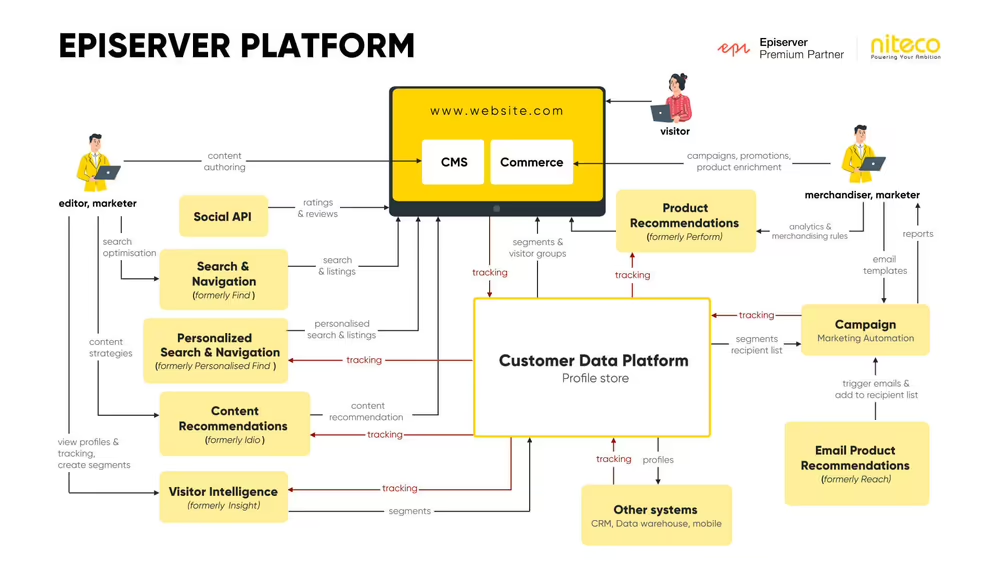For those not familiar with it, Optimizely’s platform may be hard to grasp. As a certified Optimizely partner, Niteco gives you a quick tour of Optimizely’s different functionalities and modules so you can decide what you need.
The Optimizely Platform has grown considerably since its inception 25 years ago. Now in version 11 for CMS and 13 for Commerce, it has grown from a simple framework for website development into a platform encompassing a vast number of systems, supporting businesses in this age of digital transformation.
Optimizely has recently been named a leader in DXPs (Digital Experience Platforms), extending beyond just a CMS or Commerce platform to a platform that allows businesses to put the focus back on the customer, providing a personalized and unified experience across the many touchpoints that are available in this day and age. Its size may be daunting, however, so to make understanding the Optimizely platform easier, we’ve put together this overview, explaining each component of the platform.

Optimizely CMS
For several years now, Optimizely has been known to be a leader in the Web Content Management space. Just check Forrester and Gartner’s Magic Quadrant. Its powerful content management capabilities empower editors to take full control of the website’s content and support them in their day-to-day marketing activities. This includes on-page editing, scheduling of content publishing, bulk content authoring, approval workflows, forms, A/B testing, SEO, social media integration and personalization, all via a user-friendly, intuitive UI. Optimizely also supports headless CMS options for businesses with multiple touchpoints.
Optimizely Commerce
Not only does it have a powerful web content management, Optimizely also has very strong Commerce capabilities (check Gartner’s Magic Quadrant for Digital Commerce). It has a very easy to use UI to manage markets, products, pricing, inventory, carts and orders, as well as setting up discounts and promotions. It can easily integrate with the usual Commerce support systems such as an ERP, PIM, OMS, DAM, payment gateways, marketing automation and so on. And it blends well with the CMS capabilities, providing marketers on-page editing abilities for product listing and detail pages and letting them easily manage campaigns, banners and landing pages.
More reading:
- Optimizely Commerce 13 is out
Optimizely Search and Navigation
Previously known as Optimizely Find, Optimizely also offers an Enterprise search service that’s hosted in the cloud. It can power the website’s search results and autocomplete, as well as be the engine to your product listing pages and news listing pages. It has built-in tracking abilities to help content marketers analyze the search performance of the website and optimize these with features like Best Bets, Related Queries, Synonyms, and customized weight boosting.
More reading:
- How to make the most of Optimizely Search and Navigation
- See Personalized Search and Navigation below
Optimizely Visitor Intelligence
A lot of businesses have abandoned traditional product-driven and business-driven methodologies for a more customer-centric strategy. We are in the midst of a revolution where the customer is in the driver’s seat, willing to pay for a better customer experience and abandoning businesses with which they’ve had a poor experience. To provide a great experience to the customer, understanding them is key.
Previously known as Optimizely Insight, Optimizely Visitor Intelligence allows you to track, analyze and identify your customers. It gives you the ability to segment your customers based on several themes, including demographics, Commerce behavior, as well as omnichannel behavior (i.e. customers who purchased online and offline/in-store). Part of Optimizely Visitor Intelligence is the Optimizely CDP, as explained below.
Optimizely CDP – Customer Data Platform
At the heart of a customer centric platform is where you usually will find a CDP. It works behind the scenes to collect and centralize customer data from different touchpoints and make it available to the website so it can provide a unified and personalized experience to the customer.
Initially called the Optimizely Profile Store, Optimizely has a CDP that enables you to track user behavior on the website (i.e. pageviews, products and categories interacted with) as well as behavior captured from other external but related systems, such as mobile apps, kiosks, etc. It can also combine profiles to identify the same user across multiple devices. With all the data available, Optimizely’s AI-based products such as Optimizely Product Recommendations, Optimizely Content Recommendations, and Optimizely Personalized Find can all serve relevant content to the customer, improving their overall experience, and making the lives of marketing teams a lot easier.
Optimizely Product Recommendations
While the CMS itself already has personalization capabilities with visitor group criteria including geolocation, pageviews, time of day, and acquisition, all of these are rules-based. This means editors and marketers will have to set up these rules to achieve the personalization they want for the website. This is great for when the personalization required is simple and the number of rules is manageable.
However, if your website requires more than just rules and trends, Optimizely comes with AI-based personalization capabilities for your website. It doesn’t require rules to be manually set up by marketers, but rather learns to understand the customer. It then provides the customer with a personalized and individualized experience, one that recommends products based on the customer’s interactions with the website. This includes visited products, products added to cart, categories visited, and products searched and purchased. This does not require interference from a marketer and is all done via machine learning. Backed by the Optimizely CDP (explained above), Optimizely Product Recommendations can also provide a unified experience, being able to recommend products not just based on website behavior, but also on other touchpoints (i.e. offline or in-store experiences).
Optimizely Email Product Recommendations
Individualized experiences should extend beyond just the website and into email communications. Optimizely Email Product Recommendations provides just that, personalized product recommendations inserted into your email campaigns. Marketers can construct emails around individualized customer product suggestions to provide that unique 1-to-1 messaging which has been proven to significantly increase click-through rates, driving more traffic to the website via email. Outside of marketing campaigns, this can also be used in transactional emails as well as triggered messages, covering abandoned basket emails, welcome messages, order confirmation and so on.
Optimizely Marketing Automation
Also known as Optimizely Campaign, this can be an addition to your Optimizely platform or be used as a standalone marketing automation tool, integrating easily into most CMS, Commerce and CRM systems. It provides marketers with a powerful editor to create anything from one-shot smart campaigns all the way to complex multi-step campaigns. It allows the use of several channels, including email communications, print, mobile push and SMS. It also seamlessly integrates into Optimizely Visitor Intelligence, allowing you to use and target your already created user segments as recipient lists to your campaigns. In addition, it also provides some performance analysis to your campaigns, with reports including KPIs, post-click tracking and visual link analysis.
Optimizely Content Recommendations
Last but not least, Optimizely has recently acquired Idio, a tool that has already helped many businesses serve relevant and meaningful content to end users, increasing customer engagement and improving advertising efficiency. It has a unique predictive content intelligence engine that uses a rich and deep understanding of a visitor profile and then derives the profile’s interests to be able to serve relevant content recommendations. It also provides marketing teams with helpful insights as to which content to create and produce on the website.
More reading:
- Get Optimizely Content Diagnostics for free for better digital content
Conclusion
You may be asking, “Why not have all of these functions in one system? Why does it have to be broken down, making it more complex?” The answer is quite simple. Not all customers need all of these modules. Businesses can start with the absolute minimum, perhaps just a CMS/Commerce site, and slowly grow and evolve the platform overtime. Businesses also have the option to choose other systems to integrate with their website. So, to make this integration easy, the systems have been decoupled, meaning you can easily turn things on and off and choose only what you need.
If you want to know more, speak to the Optimizely experts here at Niteco. We have 120 certified Optimizely developers, the largest number of any Optimizely partner. We have helped businesses around the globe in their digital transformation, with industries ranging from retail, healthcare, and media to finance, government bodies, and so on. Find out how we can help you.
to transform your business and drive results?



